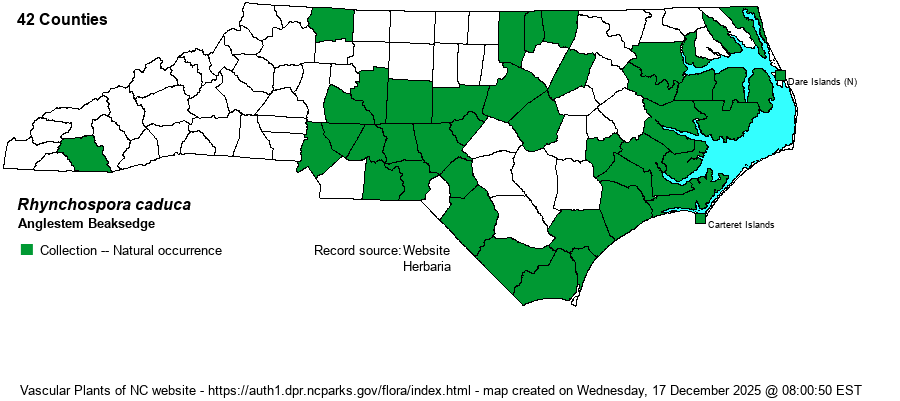| Author | Elliott | |
| Distribution | Coastal Plain (with a curious gap in the middle portion) and most of the Piedmont; rare in the low Mountains, though likely to be found in a few more southern Mountain counties, as it occurs in northern GA and southeastern TN.
VA, TN, and OK, south to southern FL and TX. | |
| Abundance | Infrequent to frequent in the Coastal Plain and Piedmont, but very rare in the Mountains and the northwestern portion of the Piedmont. The State Rank appears to be S4. | |
| Habitat | Fresh tidal marshes and swamps, wet pine flatwoods and savannas, inland marshes, margins of impoundments, seepages. | |
| Phenology | Flowering and fruiting June-September. | |
| Identification | This is a robust beaksedge, with stems 2-3.5 feet tall. It is easily confused with R. odorata, but in NC that species is generally restricted to the Outer Banks and has longer spikelets (5-7 mm vs. 3-5 mm in R. caduca). | |
| Taxonomic Comments | None
Members of the genus Rhynchospora -- mainly called beaksedges but also called beakrushes -- are mostly Coastal Plain in distribution and are important members of our longleaf pine savannas, flatwoods, streamheads, depression ponds, Carolina bays, and beaver ponds. They vary from small and wiry to large and coarse. Keys concentrate on features of the achenes (seeds) and the shape and arrangement of the flower clusters (spikelets). The seeds may or not have bristles at their base; bristle number, length, and toothing are critical characters. Size and shape of the seed beaks is also critical. The drawings in Godfrey & Wooten (1979) are extremely helpful. The genus now includes Dichromena, the white-topped sedges. | |
| Other Common Name(s) | Falling Beaksedge | |
| State Rank | S3? [S4] | |
| Global Rank | G5 | |
| State Status | | |
| US Status | | |
| USACE-agcp | OBL link |
| USACE-emp | OBL link |

